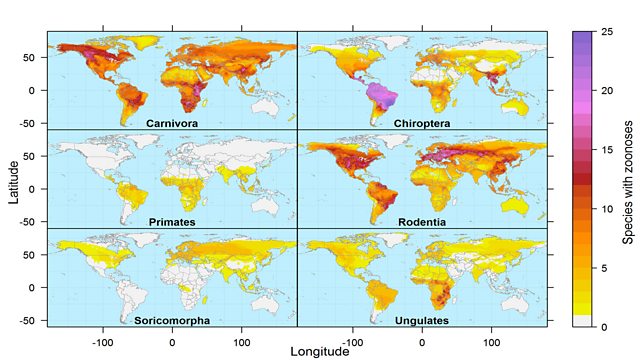First Maps of Diseases Which Spread from Animals to Humans
Diseases like Ebola and Zika hit the headlines – but did you know they originally came from animals? New maps pinpoint which animals are behind infections.
There are many infections in humans which originate from animals. Diseases which spread in this way are called zoonoses. Zika is one example and was first discovered in a monkey with a mild fever in the Zika forest in Uganda in the 1940s. Another is Middle Eastern Respiratory Syndrome or MERS – which originates in camels. A team from the United States has just mapped where they are found in the world and which animals are harbouring them. And, the map has thrown up a lot of surprises – with bats being behind far fewer zoonotic illnesses than previously thought. Dr Barbara Han, who is a disease ecologist at the Cary Institute of Ecosystem Studies, says half of carnivore species spread disease – far higher than previously thought and Europe is a “hotspot” for zoonoses.
There is a long history of maps being used to track the spread of disease – starting with John Snow. He worked out that cholera was a water-borne infection by mapping where people died in Victorian London – and traced it back to a dirty water pump.
If you are getting married there are lots of decisions to make – who to invite, what to wear, the food, the flowers, the honeymoon. One practical issue which couples should also consider is which contraceptive to use if they do not want to start a family straight away. In Nepal a new website is aiming to improve knowledge of reproductive health by combining wedding tips alongside information on family planning. Nepal has one of the highest rates of child marriage in the world, coupled with low use of birth control. The charity behind the website - Marie Stopes International - hope that couples will continue to use the website and their clinics long after the wedding is over.
Can you juggle lots of jobs at the same time? If you can carry out lots of mental tasks simultaneously without denting your performance then you may be what psychologists have dubbed "supertaskers". They make up a mere 2.5% of the population. Now a team in Australia has put a test together online so that you can find out if you are a supertasker.
Jason Watson, who is a cognitive neuroscientist at the University of Colorado in Denver, Colorado, was part of the team which discovered that only a few people are supertaskers. They got people to drive in a simulator whilst talking on the phone, solving maths problems, and learning lists of words. The supertaskers then had a brain scan to find out how they managed all of those tasks together.
Andrew Heathcote is professor of Mathematical Psychology at the University of Tasmania. Along with colleagues from the University of Utah, he developed the online Supertasker test for the BBC. It needs to be done on a computer – not a tablet or a mobile phone – and takes about 40 minutes to complete. And it needs to have a keyboard that is not on-screen. It’s very hard as it is intended to separate out that 2.5% of people who are Supertaskers. But you can try it again if it does not make sense. Second time around our presenter Claudia Hammond did much better than when she started. But she did not make it to Supertasker status – and blamed the noisy office where she took the test!
(Photo: Maps of geographic ranges of mammal species recognised to carry one or more zoonotic diseases. Credit: Drew Kramer)
Last on
Broadcasts
- Wed 15 Jun 2016 21:32GMTBBC World Service except East and Southern Africa & News Internet
- Thu 16 Jun 2016 01:32GMTBBC World Service Americas and the Caribbean
- Thu 16 Jun 2016 02:32GMTBBC World Service Online, Europe and the Middle East & UK DAB/Freeview only
- Thu 16 Jun 2016 03:32GMTBBC World Service East Asia & South Asia only
- Thu 16 Jun 2016 04:32GMTBBC World Service Australasia
- Thu 16 Jun 2016 06:32GMTBBC World Service East and Southern Africa & Europe and the Middle East only
- Thu 16 Jun 2016 14:32GMTBBC World Service except News Internet
- Sun 19 Jun 2016 19:32GMTBBC World Service East and Southern Africa
Podcast
-
![]()
Health Check
Health issues and medical breakthroughs from around the world.


